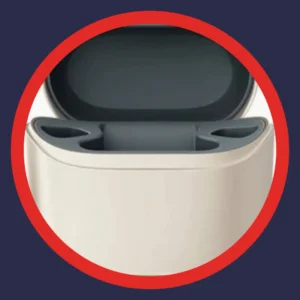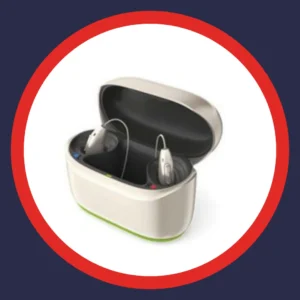Rechargeable hearing aids have transformed daily routines for people with hearing loss. With built-in lithium-ion batteries, smart connectivity, and easy overnight charging, these devices are more convenient than ever. Let’s explore how these hearing aids simplify life in every setting.
No More Battery Hassles
Traditional hearing aids rely on disposable batteries. These tiny power sources are often difficult to handle. They also run out unexpectedly and must be replaced every few days. For many users, especially those with arthritis or low vision, this daily hassle creates stress.
Rechargeable hearing aids eliminate this problem entirely. With a lithium-ion battery sealed inside the device, you never have to fumble with battery doors or replace cells. Just place the devices in a charging case before bed. Wake up to fully charged aids that last all day.
According to a Hearing Review study, users of rechargeable devices save time, experience fewer interruptions, and find the devices much easier to use.
All-Day Power Without Interruption
A full charge offers dependable hearing throughout your day. Most models provide 16 to 30 hours of battery life on a single charge. Even with heavy streaming of phone calls, music, or TV, these hearing aids rarely need a midday boost.
Phonak’s Audéo Infinio Sphere, for example, offers over 36 hours of battery life under typical use. The Starkey Edge AI provides up to 51 hours between charges. ReSound Vivia’s MicroRIE model lasts up to 30 hours.
These numbers mean you can go from breakfast to bedtime without worrying about losing sound.

Simpler Morning and Evening Routines
Your daily routine becomes easier with rechargeable hearing aids. In the morning, just take them out of the charging case and put them on. No testing batteries or packing spares.
At night, you don’t need to check power levels or open battery doors. Simply place them back in the charging dock. The process is effortless and takes just seconds.
This routine provides peace of mind. You start and end each day with confidence in your hearing performance.
Ideal for Active Lifestyles
Rechargeable hearing aids are built for movement. Brands like Phonak, ReSound, Starkey, and Unitron design their devices to keep up with your life.
Most models include IP68 ratings for water and dust resistance. You can exercise, hike, or garden without worrying about moisture damaging your devices.
Some hearing aids, like the Starkey Genesis AI, include motion sensors that detect when you’re walking or turning your head. The devices adjust sound directionality accordingly, giving you clearer hearing during physical activity.
Work and Meetings: Always Hear Clearly
Rechargeable hearing aids shine in professional settings. Whether you’re leading a meeting or on a video call, your devices stay powered and perform reliably.
The Phonak Audéo Infinio Sphere includes AutoSense OS 6.0. This feature automatically adjusts to different sound environments. Transitioning from a quiet office to a noisy conference room becomes seamless.
Starkey’s Edge AI includes advanced speech enhancement. It improves clarity by up to 30% compared to earlier models. You can understand coworkers better, even in group conversations.
ReSound’s Vivia line enhances speech in the direction you’re facing. This helps in interviews, brainstorming sessions, and team discussions.
Compare the Resound Vivia and the Starkey Edge AI.
Effortless Connectivity for Streaming
Modern rechargeable hearing aids double as wireless headphones. Connect them directly to your smartphone, tablet, or TV for audio streaming.
Phonak’s Bluetooth 5.3 technology ensures low-latency connections. You can stream calls or music without dropouts. ReSound Vivia supports Bluetooth Low Energy Audio and Auracast, which are perfect for upcoming public audio systems.
Starkey Edge AI and Genesis AI also offer hands-free calling and media streaming. Their Bluetooth connectivity is compatible with most modern devices.
Watching TV? Pair your aids with a dedicated TV connector for crystal-clear sound at your volume level, without disturbing others.
Rechargeability Supports Cognitive and Social Health
Hearing well throughout the day means more social engagement. That matters. Hearing loss can lead to isolation, which increases the risk of cognitive decline.
Rechargeable hearing aids reduce that risk by delivering consistent hearing. Phonak’s Spheric Speech Clarity improves signal-to-noise ratio by up to 10 dB. That means better hearing in noisy restaurants or family gatherings.
The Starkey My Starkey app tracks your social interaction levels and even monitors brain engagement. This helps maintain mental sharpness.

Easy Travel and On-the-Go Charging
Travel becomes much simpler with rechargeable hearing aids. No need to carry packs of spare batteries or hunt for replacements abroad.
Phonak’s ChargerGo case includes a built-in power bank. This allows multiple full charges without being plugged in. Perfect for flights or road trips.
Starkey and ReSound also offer premium portable charging cases. These let you recharge anywhere, anytime, even in hotel rooms without outlets near the bed.
Long-Term Cost Savings
While rechargeable hearing aids may cost more upfront, they save money over time. Disposable batteries must be replaced every 3 to 7 days. That adds up fast.
Lithium-ion batteries last the entire life of the hearing aid in most cases. You skip the cost, mess, and inconvenience of battery purchases.
Over several years, this makes rechargeable models a smart investment.
Environmentally Friendly Choice
Disposable hearing aid batteries contribute to landfill waste. One user can go through hundreds of batteries in just a few years.
Rechargeable hearing aids use far fewer materials. By switching, you reduce your carbon footprint while still enjoying top-tier hearing.
Choosing rechargeable devices is a win for both you and the planet.
Durable and Reliable Technology
Modern rechargeable hearing aids are built to last. Phonak, ReSound, Starkey, and Unitron test their devices rigorously for moisture, dust, and impact resistance.
All models mentioned include IP68+ durability ratings. This means they can withstand sweat, rain, and even accidental splashes.
They also include features like automatic shutoff and temperature monitoring, which protect battery health during storage and charging.
Maintenance Made Simple
Rechargeable hearing aids simplify maintenance. There are no battery compartments to clean. Just wipe down the casing daily and clean ear tips as recommended.
The charging case also protects and stores the aids overnight. It doubles as a dehumidifier in some models, removing moisture that could harm internal components.
Keep charging contacts clean and free from debris. Your devices will remain reliable and efficient for years.
Two Types of Rechargeable Batteries
Most rechargeable hearing aids use lithium-ion batteries. These do not have a removable battery door and typically last four to five years. Charge them nightly and they will maintain performance through daily use.
Some older models use silver-zinc batteries. These do include battery doors and need replacement after about one year. While rare, some providers may still carry them.
Ask your provider which type you have. For lithium-ion, always store aids in the charging dock when not in use. Never leave them in an unplugged charger, as this can drain the battery.
Advanced AI and Health Tracking Features
Rechargeable hearing aids don’t just make life easier. They also make it smarter.
Starkey’s Edge AI and Genesis AI include AI-driven sound processing that mimics how your brain interprets sound. With over 80 million adjustments per hour, speech clarity improves significantly.
ReSound Vivia uses Deep Neural Network training to mimic natural sound processing. It understands both quiet and noisy environments.
Phonak’s DEEPSONIC chip uses real-time machine learning to adapt instantly to your surroundings. It improves speech understanding without extra effort.
Apps from Starkey (My Starkey), Phonak (myPhonak), and ReSound (Smart 3D) allow remote adjustments, fitness tracking, and location services.

Rechargeable Models to Consider
Each manufacturer offers excellent rechargeable options:
Phonak
- Audéo Infinio Sphere: Dual-chip design with DEEPSONIC AI and up to 36+ hours battery.
- Audéo Life Lumity: Waterproof, with StereoZoom and Bluetooth 5.3.
Starkey
- Edge AI: Advanced sound clarity, motion sensors, health tracking, and 51-hour battery.
- Genesis AI: Custom-fit, intelligent sound, and health alerts.
ReSound
- Vivia MicroRIE: 30-hour charge, natural sound, Auracast-ready.
- Nexia: Tap control, All-Around Directionality, and fast Bluetooth.
Unitron
- Vivante Moxi V-R: Face-to-face clarity, FLEX trial tech, and environmental awareness.
- Blu Platform: Real-time personalization and hands-free streaming.
These models offer different styles, features, and price points. Your hearing care provider will guide you to the best fit.
Questions to Ask Your Hearing Care Provider
When considering rechargeable hearing aids, be sure to ask:
- How long does a full charge last?
- What is the typical battery lifespan?
- Does the charger offer quick charge?
- Are portable chargers available?
- What happens if the battery fails?
- Is the charger included in the price?
These answers help you prepare for the long-term care of your device.
Find out about CROS hearing aids and their battery options.
A Better Daily Experience
From easier routines to better hearing in noise, rechargeable hearing aids improve your daily quality of life. You no longer worry about running out of power. You engage more in work, conversations, and recreation.
They also protect your budget and the environment.
And with AI features, you get a smarter, healthier hearing experience.
Final Thoughts
Rechargeable hearing aids are more than a convenience. They are a leap forward in comfort, technology, and independence. If you’re ready to make the switch or want to explore your options, help is available.
Contact American Hearing + Audiology to schedule your hearing consultation and discover the rechargeable models that fit your life best.



